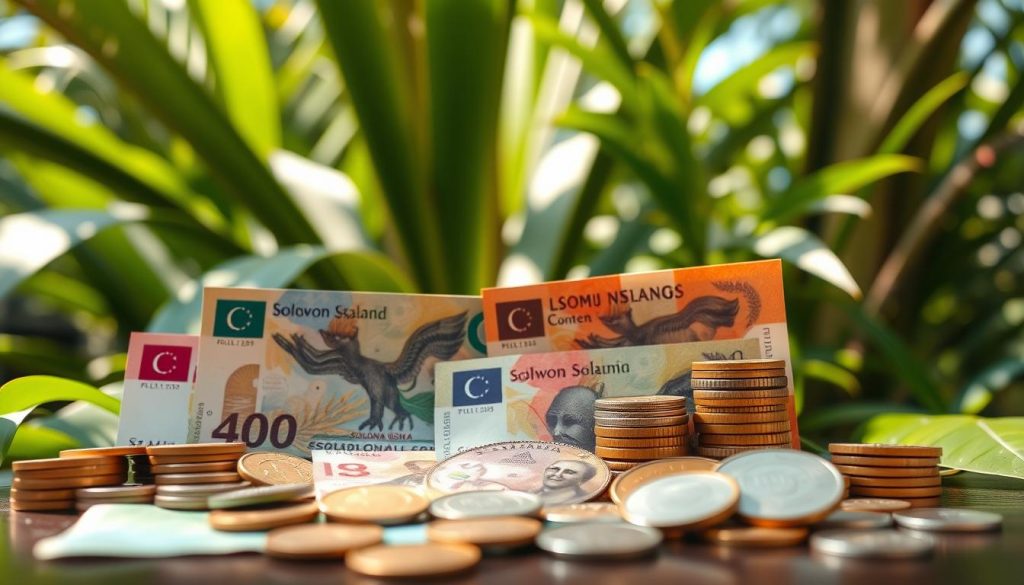✓ Accommodations✓ Flights✓ Rental Cars✓ Tours & Activities
Did you know that the Solomon Islands Dollar (SBD) has a unique exchange rate that can significantly impact your travel budget? Understanding how to manage your money here is essential for a smooth trip. This guide will help you navigate the local currency and payment methods with ease.
When planning your journey, it’s crucial to know the live USD/SBD exchange rate. This ensures you get the best value for your money. Exchanging cash at airports might seem convenient, but city centers often offer better rates and lower fees.
Travel cards and pre-planned exchanges can save you time and stress. Real-life experiences show that being prepared with the right payment methods makes your adventure more enjoyable. Let’s dive into how you can manage your finances smartly before you depart.
Introduction: Embracing the Solomon Islands’ Currency Experience
Handling money in a new destination can feel overwhelming, but it doesn’t have to be. The currency environment here is unique, and understanding it can make your trip smoother and more enjoyable. Planning ahead is the best way to avoid unnecessary stress and unexpected costs.
One of the first things to consider is exchanging money before you arrive. This helps you get better rates and avoid high conversion fees. Hidden fees and markups can add up quickly, so being prepared saves you both time and money.
Here are a few tips to keep in mind:
- Exchange cash in advance to lock in favorable rates.
- Be aware of potential pitfalls like dynamic currency conversion fees.
- Carry a mix of payment options, including cash and cards, for flexibility.
By taking these steps, you’ll feel more confident managing your finances during your trip. A little preparation goes a long way in ensuring a seamless and enjoyable experience.
Overview of the Solomon Islands Currency System
Understanding the local currency structure is key to managing your finances effectively. The Solomon Islands Dollar (SBD) is the official currency, and it’s divided into banknotes and coins. Banknotes come in denominations of $5, $10, $20, $50, and $100, while coins are available in 10, 20, and 50 cents, as well as $1 and $2.

When exchanging money, you’ll notice that rates vary between local banks and exchange providers. This happens because each provider adds their own markup to the interbank rate. To get the best way to save, compare rates before making a transaction.
In urban areas, you’ll find ATMs and banks readily available. However, in villages, cash is still the primary option. Many hotels and larger vendors accept credit cards, but smaller shops often prefer cash. Carrying a mix of both ensures you’re prepared for any situation.
Here’s a quick comparison of popular exchange providers:
| Provider | Exchange Rate (AUD/SBD) | Transfer Speed | Fees |
|---|---|---|---|
| ANZ | 5.2077 | 1-2 days | $9 AUD (online) |
| Remitly | 5.0720 | 0-2 days | $103.60 AUD |
| Commonwealth Bank | 5.0273 | 1-3 days | $30 AUD (in-branch) |
| OFX | 5.0053 | 1-3 days | No transfer fee |
Using a multi-currency travel card is another smart option. It allows you to lock in rates and avoid hidden fees. By understanding the local system, you’ll find it’s the best way to manage your money seamlessly.
Understanding the USD/SBD Exchange Rate
Getting the best value for your money starts with understanding the USD/SBD exchange rate. This rate determines how much you’ll get when converting your dollars, and it can significantly impact your budget. Knowing the difference between mid-market and markup rates is essential for making smart financial decisions during your trip.
Mid-Market Rate vs. Markup Rates
The mid-market rate is the real exchange rate used by banks and financial institutions. However, when you exchange money, providers often add a markup to this rate. This means you’ll pay more than the actual value. For example, if the mid-market rate is 5.00 SBD per USD, a provider might offer 4.80 SBD instead.
Here’s how to avoid overpaying:
- Compare rates from multiple providers before making a purchase.
- Use trusted online tools like XE.com to track the mid-market rate.
- Be aware of hidden fees that can inflate costs.
Monitoring Live Exchange Rates
Tracking live exchange rates ensures you get the best deal. Many websites and apps provide real-time updates, so you can exchange money at the most favorable times. This is especially useful when planning larger purchases or managing your daily budget.
Here are some tips for staying informed:
- Bookmark reliable currency conversion websites for quick access.
- Set up rate alerts to notify you when the rate improves.
- Avoid last-minute exchanges, as rates can fluctuate unexpectedly.
By mastering the USD/SBD exchange rate, you’ll save money and enjoy a stress-free financial experience at your destination. A little preparation goes a long way in ensuring your trip stays within budget.
Preparing Your Finances Before Traveling
Smart financial preparation ensures you get the most out of your travel budget. Taking a few steps before your trip can save you time, money, and stress. This section will guide you through the best practices for managing your finances effectively.

Exchanging USD to SBD in Advance
Exchanging your money before arriving is one of the best ways to secure favorable rates. Local banks and exchange providers in your city often offer better prices than those at your destination. This approach also helps you avoid last-minute hassles.
Using a multi-currency card is another excellent option. Services like Wise allow you to lock in rates and minimize fees. This ensures you’re ready to spend as soon as you arrive.
Avoiding Costly Airport Exchanges
Airport exchange services are convenient but often come with higher prices and fees. These providers take advantage of travelers who need immediate access to local currency. To avoid overpaying, plan ahead and exchange your money before you leave.
Here are a few tips to keep in mind:
- Compare rates from multiple providers to find the best deal.
- Carry a mix of cash and cards for flexibility.
- Use trusted online tools to track live exchange rates.
By following these steps, you’ll ensure a smooth and cost-effective financial experience during your trip.
Payment Options on Your Trip: Cash, Cards, and Travel Money
Managing your money while traveling doesn’t have to be complicated. Knowing your payment options ensures you’re prepared for any situation. Whether you prefer cash, cards, or travel money solutions, each method has its advantages.
Carrying cash is essential for smaller purchases or in areas where card payments aren’t accepted. However, relying solely on cash can be risky. Mixing it with electronic payment methods like credit cards or travel money cards offers flexibility and security.
Benefits of Using a Multi-Currency Travel Card
Multi-currency travel cards are a game-changer for frequent travelers. They allow you to hold and manage multiple currencies in one place. This means you can lock in favorable exchange rates before your trip, saving you money on fees.
Providers like Wise and Revolut offer competitive rates and low transaction fees. These cards also provide instant notifications for every transaction, adding an extra layer of security.
“Travel cards are perfect for those who want to avoid foreign transaction fees and enjoy seamless spending abroad.”
Here’s why travel cards stand out:
- Lock in exchange rates to avoid rate fluctuations.
- Low or no foreign transaction fees compared to traditional cards.
- Secure and convenient for contactless payments and ATM withdrawals.
While traditional credit cards are widely accepted, they often come with high foreign transaction fees. These fees can add up quickly, especially if you’re making multiple purchases. Travel cards, on the other hand, are designed to minimize these costs.
By choosing the right payment method for each scenario, you’ll enjoy a hassle-free financial experience during your trip. A little planning goes a long way in ensuring you stay within budget and avoid unnecessary fees.
Managing Transactions and Fees in the Solomon Islands
Navigating transaction fees can make or break your daily budget while traveling. Understanding how these fees work is key to keeping your expenses in check. From ATM withdrawals to conversion charges, every transaction adds up, so being prepared is essential.

Different areas may have varying fees, so it’s important to research beforehand. For example, urban centers often have lower fees compared to remote locations. Monitoring local banking fees can save you a significant amount of money over the course of your trip.
Here are some practical tips to help you manage costs:
- Compare fees from multiple ATMs to find the best rate.
- Use multi-currency cards to avoid dynamic currency conversion fees.
- Plan your withdrawals to minimize the number of transactions per day.
Real-life examples show how small fees can accumulate. For instance, a $3 ATM fee might seem minor, but if you withdraw cash every day, it adds up quickly. By being mindful of these costs, you can stretch your budget further.
Lastly, take advantage of competitive areas where fees are lower. Researching local banking options and using trusted providers can make a big difference. With a little planning, you can enjoy your trip without worrying about hidden expenses.
Tips for Using ATMs and Local Bank Services
Accessing cash while traveling can be straightforward if you know the right strategies. ATMs are widely available, but fees can add up quickly. By planning in advance, you can minimize costs and enjoy a smoother financial experience.
Minimizing ATM Withdrawal Fees
One of the best ways to save money is by choosing ATMs with lower fees. Banks like ANZ and Westpac often offer better rates compared to independent ATMs. Always check for foreign transaction fees on your credit or debit card before withdrawing cash.
Here are some practical tips:
- Notify your bank about your travel plans to avoid security blocks.
- Use multi-currency travel cards like Wise to lock in favorable exchange rates.
- Withdraw larger amounts less frequently to reduce the number of transactions.
Local bank services can also be a great option. Many banks offer competitive rates for cash withdrawals and everyday transactions. Researching these options in advance can save you both time and money.
Travel cards from providers like Wise and Revolut are excellent alternatives. They often come with low or no foreign transaction fees, making them a cost-effective choice. By choosing the right payment method, you can enjoy a hassle-free financial experience during your trip.
“Using a travel card with no foreign transaction fees is the best way to manage your money abroad.”
Lastly, always check your credit card’s international policies. Some cards offer benefits like no foreign transaction fees, which can significantly reduce your expenses. With a little preparation, you can navigate local banking services with ease and confidence.
Solomon Islands: Ultimate Travelers Guide to Currencies & Payments
Ensuring a smooth financial experience abroad starts with proper preparation. Handling money wisely can make your trip more enjoyable and stress-free. Here are some essential tips to help you navigate transactions with ease.
First, always check exchange sites for the best rates. Local banks and trusted providers often offer better deals than airports. This simple step can save you money and ensure you get the most out of your budget.

Using a multi-currency travel card is another smart move. These cards allow you to lock in favorable rates and avoid hidden fees. Providers like Wise and Revolut are excellent choices for frequent travelers.
Here’s a quick recap of best practices:
- Carry a mix of cash and cards for flexibility at every place.
- Be aware of dynamic currency conversion fees when using cards.
- Plan your withdrawals to minimize ATM fees.
Understanding local payment culture is also crucial. In some areas, cash is still the preferred method, especially in smaller shops or remote sites. Being prepared with the right payment options ensures you’re never caught off guard.
“A little preparation goes a long way in ensuring a seamless financial experience during your trip.”
Lastly, always monitor your transactions and fees. Small charges can add up quickly, so being mindful of your spending helps you stay within budget. By following these tips, you’ll enjoy a hassle-free financial experience as a tourist in any place.
Best Practices for Dynamic Currency Conversion
Dynamic currency conversion can sneak hidden costs into your transactions if you’re not careful. This service allows merchants to charge you in your home currency instead of the local one. While it might seem convenient, it often comes with unfavorable rates and extra fees.
For example, if you’re paying in USD instead of SBD, the merchant’s exchange rate might be higher than your bank’s. This means you’ll end up paying more for the same purchase. Always opt for local currency to avoid these unnecessary charges.
- A $50 purchase might cost $55 after conversion fees.
- Merchants often mark up rates by 3-5%, increasing your expenses.
- Your bank might also charge a foreign transaction fee on top of the conversion.
To avoid these costs, follow this simple guide:
- Always choose to pay in SBD when using your card.
- Decline dynamic currency conversion offers at the point of sale.
- Check your transaction details carefully to ensure you’re not overpaying.
Using a multi-currency travel card is another smart move. These cards let you lock in favorable rates and avoid hidden fees. Providers like Wise and Revolut are excellent choices for frequent travelers.
“Paying in local currency is the best way to save money and avoid unnecessary fees during your trip.”
Lastly, always monitor your bank statements. Small charges can add up quickly, so being mindful of your spending helps you stay within budget. By following these tips, you’ll enjoy a hassle-free financial experience abroad.
Local Merchant Payment Practices and Cash Tips
Navigating local payment customs can enhance your travel experience significantly. Understanding how to handle small purchases and tipping practices ensures smooth interactions with local merchants. Whether you’re exploring home markets or enjoying a resort stay, being prepared with the right payment methods is key.
Navigating Small Purchases and Tipping
In many areas, cash is the preferred method for small transactions. Vendors often avoid card payments due to high fees or limited access to digital systems. To make sure you’re ready, carry small denominations of the local currency for everyday purchases like snacks or souvenirs.
Tipping customs vary, but showing appreciation is always appreciated. In some places, a small tip is expected, while in others, it’s optional. Here’s a quick guide to help you navigate tipping:
- Restaurants: 5-10% of the bill, if service isn’t included.
- Tour guides: $5-$10 per day, depending on the service.
- Hotel staff: $1-$2 for porters or housekeeping.
Using cash for these transactions ensures you’re prepared and respectful of local customs. It also helps you avoid dynamic currency conversion fees that can inflate costs.
Why Some Vendors Prefer Cash
Many local merchants rely on cash due to limited access to banking services. In rural areas, digital payment systems are often unavailable, making cash the only option. Even in urban centers, some smaller shops avoid card payments to save on transaction fees.
Here’s a comparison of payment acceptance rates in different areas:
| Location | Cash Acceptance | Card Acceptance |
|---|---|---|
| Urban Markets | 80% | 50% |
| Rural Areas | 95% | 20% |
| Resorts | 60% | 90% |
By understanding these practices, you can handle transactions smoothly and show respect for local customs. A little preparation goes a long way in ensuring a seamless travel experience.
Balancing Your Trip Budget and Currency Needs
Planning your daily expenses in advance can make your trip stress-free and enjoyable. By understanding local costs and setting a clear budget, you’ll avoid overspending and focus on exploring the world around you. This section provides practical guidelines to help you manage your money wisely.
Daily Expense Guidelines in SBD
Knowing how much to spend each day ensures you stay within your budget. Here’s a breakdown of average daily costs for different travel styles:
| Travel Style | Daily Cost (SBD) | Weekly Cost (SBD) |
|---|---|---|
| Budget | 117 | 816 |
| Mid-Range | 266 | 1,864 |
| Luxury | 509 | 3,562 |
For meals, budget travelers can expect to spend around $22 SBD per day, while mid-range and luxury travelers may spend $49 and $95 SBD, respectively. Local markets often offer affordable options, making them a great choice for saving money.
Strategies for Managing Your Money
Here are some practical tips to help you balance your budget:
- Set aside a daily amount for meals, transportation, and attractions.
- Track all transactions to avoid overspending.
- Use local markets for affordable souvenirs and snacks.
By following these guidelines, you’ll enjoy a seamless financial experience during your trip. A little preparation goes a long way in ensuring you stay within budget and make the most of your adventure.
Insider Tips for a Seamless Financial Experience Abroad
Maximizing your financial efficiency abroad starts with a few insider tips. These strategies ensure smooth transactions and help you avoid unnecessary fees. Whether you’re planning your arrival or managing daily expenses, these tips will keep your finances in check.
Upon arrival, exchange a small amount of cash at the airport for immediate needs. However, avoid large transactions here due to higher fees. Instead, visit local banks or trusted exchange providers for better rates. This simple step can save you money right from the start.
Combining payment methods is another smart move. Use a mix of cash, credit cards, and multi-currency travel cards for flexibility. In unexpected cases, like card freezes, having multiple options ensures you’re never stranded. Always notify your bank about your travel plans to prevent disruptions.
Managing various travel activities without worrying about hidden costs is easier with these tips:
- Track your spending daily to stay within budget.
- Use apps like Wise or Revolut for low-fee transactions.
- Avoid dynamic currency conversion by paying in local currency.
Here’s a quick comparison of payment methods to help you decide:
| Method | Pros | Cons |
|---|---|---|
| Cash | Accepted everywhere, no fees for small purchases | Risk of loss or theft |
| Credit Cards | Widely accepted, offers rewards | High foreign transaction fees |
| Travel Cards | Low fees, locks in exchange rates | Limited acceptance in rural areas |
By following these insider tips, you’ll enjoy a hassle-free financial experience abroad. A little preparation goes a long way in ensuring your trip stays smooth and enjoyable.
Conclusion
Mastering your finances while traveling ensures a stress-free and enjoyable adventure. By tracking exchange rates, avoiding costly airport exchanges, and using multi-currency cards, you can secure the best deal for your money. Planning ahead for every meal and transaction helps you stay within budget and focus on exploring.
Remember, small steps like carrying cash for local vendors and monitoring fees can make a big difference. With the right tools and knowledge, you’ll navigate your trip confidently and efficiently. Apply these tips, and your journey will be both memorable and financially savvy.
The above is subject to change.
Check back often to TRAVEL.COM for the latest travel tips and deals.





